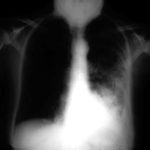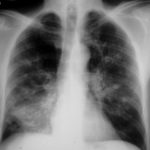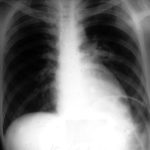Date: 26 November 2013
Copyright: n/a
Notes:
Dr Jenny Bartholomew is a Research Associate in the Institute of Inflammation and Repair, University of Manchester. A Manchester graduate – she formerly worked as a University Lecturer at Monash University, Melbourne for four years where she undertook research into the immunology of connective tissue damage and repair in rheumatoid arthritis, identifying TNF alpha in inflamed cartilage in an animal model of arthritis.
On returning to Manchester she moved to Christie Hospital, Manchester as a Research Fellow and University teacher where her main research interests were studying the immunological responses to human papillomavirus (HPV 16/18) in cervical cancer. Using recombinant vaccinia virus to express viral proteins from HPV, the major oncoproteins from HPV were studied and used in the development of the cervical cancer vaccine.
For the last 12 years she has been involved in Aspergillus research, providing clinical and scientific information to patients, doctors and scientists, she manages and publishes the Aspergillus website. This is a complex educational resource providing the latest research, technology and information for a wide diversity of users. She has a particular interest in video media and produces a broad range of video interviews from patients and clinics for educational use.
She is now engaged in global health programme. Jenny has launched the LIFE (Leading International Fungal Education) programme commencing with a public engagement and awareness project in 2012, combining Science with Art, aimed at educating young people about harmful fungi.
This was followed by the LIFE online resource (http://life-worldwide.org) for health care professionals encompassing all fungi, the infections they cause, diagnosis and treatments. This resource has a news flow about global health and is targeting global education about fungi and serious infections they can cause. The site is now being translated into Spanish and other languages will follow soon. She launched the Global Action Fund for Fungal Infection site (http://gaffi.org) in July 2013 – GAFFI is a foundation based in Geneva, focused on advocacy for access to diagnostics and treatment in every country.
Aspergillus website, Life worldwide organisation, GAFFI , National Aspergillosis Centre, Mycology Reference Laboratory and Fungal Infection Trust.
Some of my Publications:
- Bartholomew, J S, J M Evanson and DE Woolley . Rheumatol. Int., II: 37-40, 1991 Serum IgE Anti-cartilage Collagen Antibodies in Rheumatoid Patients.
- Bartholomew,J S,J M Evanson and DE Woolley . Allergy Digests, 2: 30-31, 1992 Collagen Specific IgE Antibodies in Rheumatoid Patients.
- Stacey,S N, J S Bartholomew, A Ghosh, P L Stern, M Mackett and J R Arrand. J.Gen. Vir., 73: 2337-2345, 1992 Expression of human papillomavirus type 16 E6 protein by recombinant baculovirus and use for detection of anti-E6 antibodies in human sera.
- Stacey,S N, A Ghosh, J S Bartholomew, R W Tindle, P L Stern, M Mackett and J R Arrand. J. Med. Virol., 40: 14-21, 1993. Expression of human papillomavirus type 16 E7 protein by recombinant baculovirus and use for the detection of E7 antibodies in sera from cervical carcinogen patients.
- Bartholomew,JS, S N Stacey, B Coles, D Burt, I R Arrand and P L Stern. European Journal of Immunology, 24: 3175-3179, 1994 Identification of a naturally processed HLA-A0201 restricted viral peptide from cells expressing human papillomavirus type 16 E6 oncoprotein.
- Bartholomew J and P L Stern.
In: Modulation of MHC Antigen Expression and Disease. Eds E G Blair, D J Maudsley and C P Pringle, 233-250, 1994 MHC expression in HPV associated cervical cancer. - Ellis JRM, P I Keating, J Baird, E F Hounsell, D V Renouf, M Rowe, D Hopkins, M F Duggan-Keen, J.S Bartholomew, L S Young and P L Stern. Nature Medicine, 1,464-470, 1995 An HP V 16 variant is associated with cervical carcinoma in HLA-B7 positive women.
- Bartholomew,JS, S. Glenville, S. Sarkar, D.I. Burt, M.A. Stanley, F. Ruiz-Cabens, J. Chengang, F. Garrido and P .L. Stern. Cancer Res. March 1, 1997. Integration of high-risk human papillomavirus DNA is linked to the down-regulation of Class I Human leukocyte antigens by steroid hormones in cervical tumour cells.
- Brady CS. Bartholomew JS. Burt DJ. Duggan-Keen MF. Glenville S. Telford N. Little AM. Davidson JA. Jimenez P. Ruiz-Cabello F. Garrido F. Stern PL.
Tissue Antigens. 55(5):401-11, 2000 May. Multiple mechanisms underlie HLA dysregulation in cervical cancer. - Fungi: friends or foes? Biological Sciences Review 17(1) 24-28, 2004
-
Mabey Gilsenan JE, Atherton G, Bartholomew J, Giles PF, Attwood TK, Denning DW, Bowyer P.
Aspergillus genomes and the aspergillus cloud Nucleic Acids Res. 2009 Jan;37(Database issue):D509-14. Epub 2008 Nov 27
E-mail: jennifer.bartholomew@manchester.ac.uk
Images library
-
Title
Legend
-
25/04/90 After itraconazole treatment. Major improvement, defined as a complete response, after 10 weeks therapy with itraconazole.
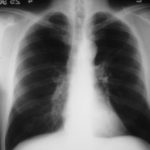
-
Image A. Chest x-ray shows a single nodule in the left mid lung field.
Image B. This emphasises how chest x-rays in this context underestimate the extent of disease. The most anterior nodule has ground glass surrrounding the nodule, a halo sign. This diagnostic feature is missed on plain chest X-rays.
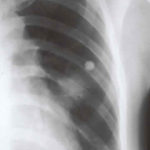 ,
, 
-
Chest X ray after 4 days, prior to treatment, showing massive increase in volume of lesion (Fig 2)
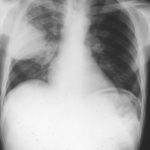
-
Image A. This patient, aged 25 years developed a non productive cough and dyspnoea in the context of late-stage AIDS, CMV disease with ganciclovir-induced neutropenia and receiving corticosteroids. His chest radiograph shows fine bilateral reticular lower-lobe shadowing. He then developed gastro-intestinal bleeding with a gastric ulcer which showed hyphae on biopsy. He then developed blindness of one eye and the globe of his eye perforated. Hyphae were seen and Aspergillus cultured from the vitreous aspirate.
Image B. This radiograph, taken 25 days after the first and 3 days before death, shows of fine bilateral lower-lobe reticular shadows progressing to nodules in all lung zones.
This patient was reported as patient 3 in Denning DW, Follansbee S, Scolaro M, Norris S, Edelstein D, Stevens DA. Pulmonary aspergillosis in the acquired immunodeficiency syndrome. N Engl J Med 1991; 324: 654-662.
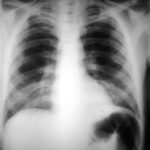 ,
, 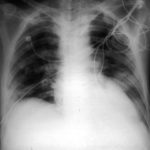
-
Further details
Image A. Bronchoscopy revealed Aspergillus on culture.
Image B. The ability of Aspergillus to cause pulmonary infarction, probably through direct angioinvasion in this case, is characteristic.
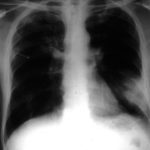 ,
, 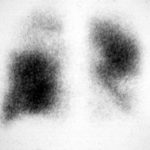
-
(Fig 1) Chest radiograph with ‘classical’ appearance of a pulmonary infarction – a wedge-shaped lesion peripherally set against the pleura.
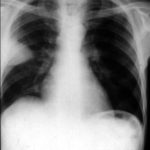
-
Large soft left upper-lobe shadow of focal invasive pulmonary aspergillosis in leukaemia, that was missed on earlier radiographs but apparent retrospectively. Variable density of the lesion suggests cavitation, which would be clearly visible on a CT scan of the thorax.
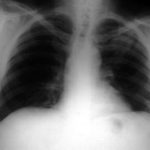
-
Severe unilateral invasive aspergillosis of the left lung, with complete consolidation of the left lower-lobe and reticular shadowing extending up into the left upper lobe. The right lung appears normal.
